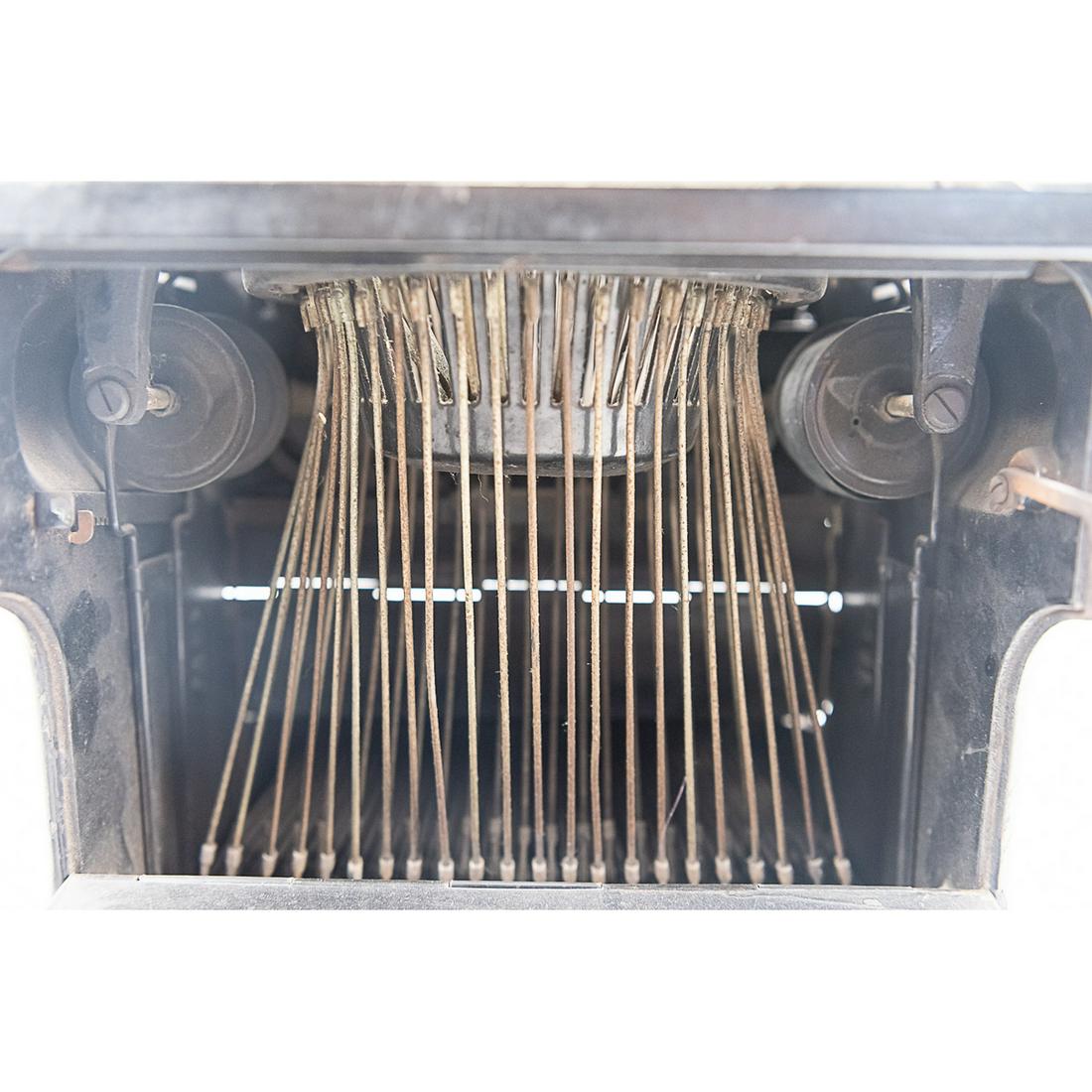 |
| Perfected Type Writer No. 2 #2518, picture by Breker Auction |
I got it
together with a Caligraph No. 2 for in total 450 euro (+23,5% commission cost).
Two months later Breker sold another PTW2, with serial number #6854. This time
it was advertised correctly as such, and therefor sold for 2000 euro.
 |
| Perfected Type Writer No. 2 #6854, picture by Breker Auctions |
The latest version of the Sholes & Glidden was called “The Perfected Type Writer”, and the PTW2 is the successor of that machine, and the first typewriter with a shifting mechanism. After this came the Standard Type-Writer № 2, which finally became the Remington Standard № 2. I had a Standard Type-Writer № 2 as well; see: https://schrijfmachine.blogspot.com/2020/05/this-is-not-remington-typewriter.html

Decal above keyboard of PTW2 #2518
The
quickest way to identify a PTW2 (apart from the decal above the keyboard) is by
looking at the center wheel, just above the metal paper scale in front of the
carriage. All PTW2’s I have seen have a shifting mechanism above the center
wheel in front of the carriage. From the Standard Type Writer № 2 onward, the
shifting mechanism changes, and the part above the center wheel is not
connected to a shifting construction anymore.
 |
| Center wheel and shifting part on top of it. PTW2 #2518 |
So far I have found 7 PTW2’s, all within the serial number range of #2518 to #7190. However, there is a picture of an 8th PTW2 in a book from 1964 about the typewriter collection of the Science Museum of London. That machine is also pictured in Beeching’s book (The Century of the Typewriter, 1974). According to the online museum catalog, this machine has number #593, and I believe this is indeed a serial number.
 |
| PTW2 #593 from the London Science Museum. Picture from museum catalog, 1964. Notice the lack of a decal above the keyboard. Above the right shift key there is only a pin stripe visible. |
From the old picture in the book, it looks like this machine doesn’t have the name “Perfected Type Writer № 2” above the keyboard. This is just like the very early Perfected Type Writers № 4, which don’t have any designation either, only pinstripes above the keyboard; see for example PTW4 #575. Unfortunately, the London Science Museum has ignored my mails (and even a letter) asking for more information.
 |
| Cast iron type basket of PTW2 #2518. |
The PTW2 from the London Science Museum (#593), my machine (#2518) and a later specimen (#2654) have a cast iron type basket, similar to the type baskets of the Sholes and Gliddens and early Perfected Type Writers № 4. See for example this S&G:
 |
| Cast iron type basket of a Sholes and Glidden Type Writer |
Later PTW2’s,
like the PTW2 #6854 that was auctioned by Breker last May, have a different
typebasket, made of metal wires. This is similar to the construction used in
later machines, like the Remington Standard № 2.
 |
| PTW2 #6854, notice the lack of a cast iron type basket |
My
Perfected Typewriter № 2 #2518 has two more peculiarities: it has both shift
keys (upper case on the left and lower
case on the right) at the lower bank of the keyboard, just above the
space bar. All other specimens I know of have the lower case key at the right
on the upper bank of the keyboard. Just like on later name variants of
this machine. No other PTW2 I know of has both shift keys at the lower bank of
the keyboard. My machine was far ahead of its time!
 |
| Lower case key of PTW2 #2518, at the bottom of the keyboard |
The second peculiarity of my machine is the “r.”-key. That’s right, a single key for two characters: the “r” and the period. It is located as uppercase character above number “5”. When searching the web for more information about the Perfected Type Writer №. 2, I stumbled upon an interesting article from Marcin Wichary about this key. Here is a quote from the article, explaining the use of this key:
“In such abbreviations as Mr. or Dr., the small letter r and period can be made with one touch by using the fourth key from the left in first row. […]
Why dedicate half a key to something so obscure, and something that looks exactly the same as typing r and . separately? The answers to both, as it turned out, required just a bit of context.
This [the Perfected Type Writer № 2) was among the first typewriters with shifting, and shifting was hard – split between Upper Case and Lower Case keys on the opposite sides of the keyboard, and requiring a lot of force to lift a heavy mechanism. Putting r. in a shifted position was a stroke of genius – in common usage (e.g. Mr. Wichary) it followed an uppercase letter, and was immediately followed by another one, so this saved a few shifts and unshifts along the way.”
Source: To
save a keyboard, pt. 1 | Revue (getrevue.co)
Author
Marcin Wichary is writing the book “Shift Happens”, which will include a
picture of my machine.
 |
| "r."-key of PTW2 #2518 |
As far as I know, the r.-key was only used for a short period of time on the Perfected Type Writer № 2. I have only seen it on my machine and on machine #2654.
Do you own a Perfected Type Writer № 2? Please leave a comment below.

3 opmerkingen:
I learned a lot from this post. Congratulations on acquiring such an interesting typewriter for a bargain price.
Thanks Richard!
Grazie
Een reactie posten